Text
WEEK 10: FORUM POST
To what extent do you agree with the notion that science is culture?
I definitely feel that science has a presence in the shaping of culture, as there is always a strong following of scientific beliefs during any time period. As such, no matter how controversial certain scientific notions about the world may be, there will inevitably be those that strongly agree and those that are more hesitant to agree with the arguments and innovations that science tries to present, meaning the arguments will always have a presence within society and induce a conversation among the individuals within the culture. In this way, I believe that although science is not the only defining factor of culture, it definitely still plays a large part in society and culture.
How do you think digital media in particular affords intersections between science and art?
Digital media affords intersections between science and art in the sense that both attempt to interpret and develop/advance methods of expression and creation, which is a large part of digital media. The dynamicity and fluidness of both science and art allows scientists to provide artists with inspiration and new mediums of expression (i.e. for example, the advancements in technology have allowed artists to create using online platforms and digital technologies that were not previously available to them). Additionally, artists can help portray scientific arguments to audiences in various forms of expression that may be more easily understandable or interpretable to individuals.
What do you think can be some benefits brought about by the convergence between science and culture? Do you also see any potential pitfalls?
Some benefits brought about by the convergence between science and culture include that it helps bring light to major discoveries or breakthroughs (i.e. in new technologies) that are majorly influential and important to the betterment of culture. It can highlight either positive discoveries that can advance our culture, such as the creation and development of self-driving vehicles, or it can highlight negative discoveries that should be known within our culture, such as the increasing effects of our actions towards global warming, which in turn can lead to increased actions fighting these cultural issues and developing solutions. One of the potential pitfalls of this convergence, however, is that people may begin to feel limited in their abilities to express themselves creatively, as they start to feel trapped within the boundaries of the facts and statements that are provided by science. This influences their ideas on what they believe is possible, thus narrowing their perspectives and deterring them from thinking outside the box.
0 notes
Text
WEEK 9: FORUM POST
What do you think is the particular value of oral history in documenting digital art and culture? Explain with examples where appropriate.
Oral history is valuable in documenting digital art and culture as this form of communication and information relaying adds an in-depth sense of personalization and humanization to the information being recounted from a certain time, as the verbal sharing of information is very subjective to the individual doing the sharing, and the context that the individual was in. Given the subjectivity and interpretivism of art itself, this subjective form of documentation is very fitting. Oral history is also valuable in the sense that forms of communication have generally shifted away from his and more towards digital forms of documentation, and thus it is interesting to analyze how different documentation has become and the effect that being able to keep a record of written (online, in print, etc. such as on social media, blogs, etc.) documentation has on the conversations surrounding digital art and culture compared to the influence that the less retrievable oral form of communication has and has had on digital culture and art throughout time.
How is intertextuality intertwined with digital art and culture? Discuss in relation to any topics from previous weeks that you feel may be appropriate.
Intertextuality, which is the relationship between different types of texts, involves the sharing of concepts and ideas from different works. This is intertwined with digital art and culture as artists often use or receive inspiration from an existing idea and express it in their own personalized ways. For example, the Hollywood Burn clip we viewed from Soda_Jerk is a clear example of how taking ideas from existing Hollywood works was used to create a different interpretation of the ideas and the messages that they were meant to portray to viewers.
How do you think ethnography can be useful in examining digital art and culture? Explain with examples from your current process in developing Task 1.
Ethnography can be useful in examining digital art and culture as it provides both artists and audiences with a broader view and perspective of individuals and their behaviours, customs, values, etc. This is useful to use in interpretations of artworks made from artists of different ethnicities, or of artworks themselves portraying elements of different ethnicities from our own. Ethnography has been useful from my group’s Task 1 process as our focus is on the fluidness of identity and self-portrayals, and with a diverse group with members from various different ethnicities, it is interesting to understand both the differences and similarities in each of our views of identity given our different backgrounds. It is especially useful in our examination of the use of social media and people’s decisions on how they choose to portray themselves to the public and their peers. It is interesting to use ethnography in understanding the reasonings behind the choices that people make when creating online personas for themselves.
How might you apply reflective curatorial practice to your own curatorial projects? Explain with examples from your current process in developing Task 1
Reflective curatorial practice can be applied to my own curatorial projects as it helps to constantly generate critical thinking of the ideas and concepts I decide to put into my own curatorial projects. Reflective curatorial practice has helped in my group’s Task 1 process as through this, we were able to narrow down our choices for the artworks we wanted to use that we thought best portrayed the messages we were trying to get across to our audience. This was especially helpful and provided a broader perspective on what we were truly trying to convey with our exhibition as we were able to apply reflective curatorial practice collectively through the sharing of our own individual reflections.
0 notes
Text
WEEK 8: FORUM POST
What do you think is the impact of current trends in social media (e.g. desire for authenticity, rejection of hierarchies, etc.) on the curation, creation and production of digital art and culture?
The current trends in social media are definitely shaping this generation’s culture in a significant way. The ability to curate or create digital art and culture has been widened to virtually anyone that wants to and is willing to put out content. This content does not need to be reviewed or screened before being posted online for anyone to see or access, and with the rejection of hierarchies, there are no restrictions as to who can post content, either (i.e. anyone can post anything they want). As such, the current trends in social media provide users with the platform and the freedom to create and share their forms of art.
How would you define art, and do you think there is (or should be) a distinction between digital, media art and other conventionally and culturally accepted forms of art? Explain with specific examples where appropriate.
Given the fluidness and interpretivism of art, I believe that it should not be given a structured definition. I believe that it can be described, however, as a way to express one’s thoughts, feelings, or opinions of virtually any topic through many different mediums. As such, art is a form of communication or expression that can be interpreted in as many ways as there are receptors of the art. It can be difficult to distinguish between digital, media art and other conventionally and culturally accepted forms of art, as they all have the same end goal of expressing an idea or opinion to the audience. Thus, with the same mission behind each type of art, I feel that a distinction between the forms is not necessary.
Between intentions of the artist and the experience of the artwork by the audience, which do you think is currently more privileged or emphasized in the context of digital art and culture? How do you think the tension between these two sides of an artwork can be reconciled? Explain with specific examples.
I feel that the experience of the artwork by the audience is currently more privileged or emphasized in the context of digital art and culture. Especially over the social media platforms, we hear more about people’s opinions and critiques of an artwork than we do of the artist’s intention of his or her creation. The growing trend of every individual wanting their opinions to be important and to be heard, more and more opinions and interpretations are coming to light, thus often having the ability to drown out the original intention of the artist. One way for the tension between these two sides to be reconciled is through immediate discussion of the artwork between artist and audience. An example of this is improvisation shows (such as Whose Line Is It Anyways?) in which audience participation is required for the show to operate. From the live aspect of these shows, the artists (the improvisors) receive immediate feedback from their audience about their opinions on their art, and they are also given the platform to alter their art accordingly, or express themselves even further so as to try to explain their expression more thoroughly to the audience.
0 notes
Text
WEEK 7: FORUM POST
What do you think are the wider societal and cultural implications of the social media ideology described by Geert Lovink?
The wider societal and cultural implications of the social media ideology described by Geert Lovink are that communication between individuals is being done mostly through these social media platforms, and this eliminates the awkwardness or tentativeness that may come with in-person interactions, as communication is now done through a screen. This creates the ability for individuals to think through their responses to others more thoroughly and essentially say exactly what they want to in the conversation, thus simulating a “perfect” conversation environment. This takes away from the aspects of actual in-person communication and interaction, which I believe is necessary for human beings. The notion of measuring one’s self-worth based on, for example, how many likes one receives on social media, is also an implication that social media has on society and culture. This reliance is dangerous for the self-confidence of the younger generation. Additionally, social media is an entity to which we as a society are becoming unable to live without in many aspects of our lives. The use of social media is being rooted into the fabric of our current culture (i.e. it is more abnormal not to use social media than to be using it). This raises the question of how much control do we have over our use of this entity, and thus over our lives.
What do you think is the aesthetic, ideological or political role of memes, within the context of the self-segregating, doubt-centric culture of the new media landscape? Provide one digital culture or digital art project that reflects this as an example for evidence to ground your response in. (Look to the weblinks on IVLE and learning materials for more resources if you are having trouble.)
Memes have been created as a form of entertainment and for viewers to feel a sense of relatability to. Many identify with the message of various memes, which is what makes them so popular/widespread and shared among friends. They are also portraying messages that are very relevant to things going on in pop culture and current events, making them relatable on various levels. An example of this is the News Memes link on Reddit (https://www.reddit.com/r/NewsMemes/), which shares various memes and user comments that are related to current events that are occurring daily.
To what extent do you agree that the increasing reliance on communication technologies by artists and cultural leaders and the simultaneous reduction in understanding of their production are a problem? Compare and contrast two works or texts to provide evidence of your position.
Although I agree to some extent that the increasing reliance on communication technologies by artists and cultural leaders and the simultaneous reduction in understanding of their production are a problem, I feel that there is a stronger argument for this increasing reliance as more of a source of positive power instead. This increasing reliance can be a powerful and positive tool in the hands of artists and cultural leaders when used effectively, such as when popular public figures or social activists, such as Tarana Burke (who began the #MeToo social movement), understand how to use their platform to reach large audiences to spread messages about relevant issues (i.e. the very prevalent sexual assault issues in modern society) that they are passionate about and that should very much so be discussed in today’s society. Additionally, artist Amelia Marzec has the educational background through her studies at Parsons that allows her to use and produce communication technologies for innovations that have interesting, positive, and thought-provoking implications for the future (i.e. her New American Sweatshop project [http://www.ameliamarzec.com/newamericansweatshop/] that raises the relevant issue of economic sustainability and brings together passionate volunteers to create new products that may very-well be or influence the future of technological product manufacturing or creation).
Describe some potential applications of critical engineering and glitch studies in works of art and cultural manifestos. Reference at least 2 Digital Culture and Arts projects / works in your response.
Critical engineering is described as “the most transformative language of our time, shaping the way we move, communicate and think”. An example of this is Amelia Marzec’s Signal Strength project (http://www.ameliamarzec.com/signalstrength/), which allows people to communicate in offline areas using add-on radio extensions to their phones to extend the range used to communicate with other cell phones. This project is a channel that allows people to communicate via technology even in areas in which they normally would not be able to, thus extending the reach of digital communication beyond what was originally thought possible.
Glitches, as described by Rosa Menkman, are “often used to deconstruct the myth of linear progress and to end the search for the holy grail of perfect technology” and “shows that accidents and errors can also be welcomed as new forms of usability”. I think this is a powerful message that accepts and welcomes unexpected errors/mistakes created in the process of creation, which is very important as errors in any context can very much be used as inspiration for learning and more well-thought-out creation. An example of glitch studies is artist Matthew Plummer-Fernandez’s piece called Digital Natives (http://www.plummerfernandez.com/Digital-Natives) in which he uses scans of distorted images and reconstructs them into new types of art in the form of everyday human artefacts such as vases and watering cans.
0 notes
Text
OBSERVATIONS OF A SPACE [WEEK 5]
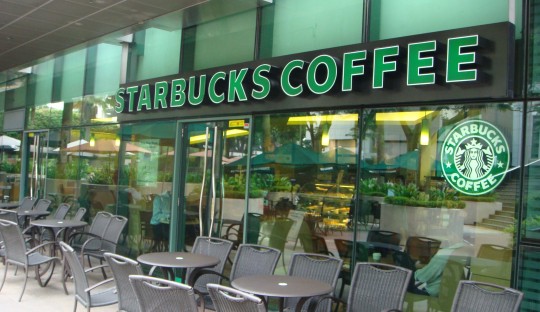
Last week, I got to spend about 2 hours sitting in a Starbucks coffee shop in the Liang Court mall. This was around 12pm, and the Starbucks shop was very busy at this time. There were many individuals waiting in the queue to buy a drink, and almost all of the available tables were occupied at this time. Most individuals were with at least one other person, however some were sitting alone. Almost all of the customers in the shop also were either using their laptops or phones for the duration of the time they were sitting in the shop. I also saw individuals of all different cultures and ethnicities sitting in the shop, and thus I could hear conversations in various different languages throughout the shop. For example, I could listen to a French man speaking on the phone next to me. The shop also emitted the typical coffee-shop noises, which consisted of the hustle and bustle of people interacting and conversing with others, the background music being played by the store, and the script of the cashiers taking orders from individuals. What was most noticeably visible was the familiar logo on the cups of each person’s drink on every table in the shop.
Similar to many of the others, I was one of the individuals sitting in the coffee shop on my own laptop, doing some work as well. While I was in the space, I felt very comfortable in the environment I was in, and I believe that is a testament to the environment that the Starbucks brand has worked to emulate. I felt like I was in a comfortable and safe space where I could be myself and do my work. I also felt motivated to complete my work after seeing and being surrounded by other individuals that all appeared to be productive in the work that they were doing. Seeing everyone going about their business in a relaxed way in the space made me feel relaxed and comfortable as well, while simultaneously wanting to get my work done. In addition, I also felt like I belonged to a community while in the coffee shop with all of the other customers. Even though we were not all interacting as one big group, we each had our own space and respected one another’s, and the environment that was established in the shop made me feel a sense of belonging.
The other individuals in the Starbucks shop were all utilizing the seats and tables provided by the Starbucks, and they all appeared to be very comfortable and relaxed in their seats. They were immersing themselves in, as well as adding to, the ambience of the coffee shop in which everyone was going about their business in a space that essentially fused together “home” and “work”. As these observations were made on a weekday in the middle of the working day, it was evident that I was observing people going about their regular weekday and getting work done by utilizing this free space that allowed them to do so in an environment where every other customer was acting similarly.
There were definitely signs of media networks and transmission signals in the space. This was most evident to me in the network that was created from customer to cashier to machine, and back again. The routine of the customer purchasing action created a network from one individual back to another. The presence of technology and online connection throughout the entire shop also emitted signs of media networks and transmission signals, as it was obvious that everyone was connected in some form to the web, all on the same Starbucks WiFi signal that coursed through the shop.
In addition to the large TV screens behind the order counter that displayed the entire menu for customers to look at and choose from as they enter the store, one of the major features of every Starbucks shop is the free WiFi that they offer to their customers. It was very clear that 100% of the individuals in the space were using this internet connection, whether it was for work that required online connection, social media, research, or surfing the web in any other way. I believe that the free WiFi is one of the main reasons that people choose to stay and sit down in the shop after they have purchased their drinks. As such, the sphere of digital culture bled into this space as everyone was connected in some way given the complementary internet connection.
Many of the customers were also using digital culture in this space by making purchases and collecting loyalty points through their Starbucks App on their smartphones. The effect that digital culture has come to play in the world of consumers, as the advancements in technology have made purchasing so much more convenient and quick for customers. Observing this space clearly demonstrated to me how much Starbucks has adapted and integrated this form of digital culture into the operations of their business.
The space itself would likely have several observations about customer behaviours and habits. For the entire day, different individuals come and go into the shop, spend their time there doing essentially whatever they wanted to do, and leave only to make room for the next individual to do exactly that. As such, there are so many patterns of behaviour that are displayed in the Starbucks coffee shop on a daily basis. The space could tell us many different things about the behaviour of these individuals, such as what drink did they order or do they normally order (i.e. if they are regular customers), which seats they choose to sit at when options are available to them, what they do first as soon as they find a seat, what they work on, who they talk to, which gadget or device do they choose to go on, if they enter alone or with a group of individuals, and on and on. If the space could say something summarized in one sentence, it would be, “I have had all kinds of interactions with more humans than humans have had with other humans”.
0 notes
Text
WEEK 5: FORUM POST
After having read about the examples in “An Infinite Séance Part 2”, what do you think it means for new media artworks to “satisfy that thirst for media-specific art and still fit perfectly into the current trends”?
I think that new media artworks satisfying the thirst for media-specific art and still fitting perfectly into the current trends means that the artists are following the “unwritten” strict rules of new media art, while simultaneously appealing to the public audience by creating content that keeps up with the current trends and attracts the modern society. It is balancing one’s own way of expressing oneself while still adhering to the strict rules of new media.
To what extent do you agree that the open source movement is reminiscent of a Marxist revolution, and why?
The Marxist revolution involves freeing the working class from the capitalist oppression. The open source movement aims to provide all users with the liberty to openly use licences for softwares for free. As such, the open source movement is reminiscent of a Marxist revolution in the sense that the main underlying idea behind both is to provide individuals with freedom in the relevant efforts that each movement is fighting for.
What do you think is the particular role that 3D printing has in the critique and imagination of radical futures?
3D printing has an important role in the critique and imagination of radical futures, as this technology allows us to develop models or prototypes quickly, conveniently, of high quality, and at a low cost. This increases the level of feasibility for any ideas of radical futures, which immensely and importantly increases our possibilities for innovation.
How do you think glitches can be useful in asking critical questions and generating creative solutions?
Glitches are defined as temporary malfunctions or errors in operation. They are a sign of something going wrong, and when glitches occur, they bring rise to questions and inquiries by individuals, and may also bring about the finding of solutions to the glitches in creative ways. As such, glitches are errors that individuals can learn from by asking questions and creating solutions. This in turn leads to the creation of new opportunities and innovations through the development of creative solutions.
0 notes
Text
CONSTRUCTIVE CRITIQUE: THE LIBRARY OF PULAU SAIGON [WEEK 5]
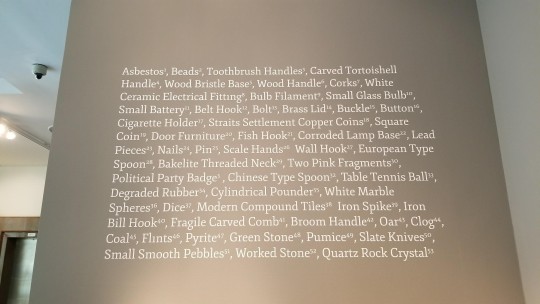
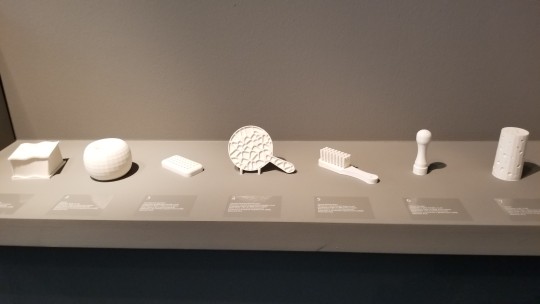
[Debbie Ding. The Library of Pulau Saigon, 2015. PLA Print]
RESPONSE
Once I spotted The Library of Pulau Saigon, I was immediately intrigued by the artwork. Its aesthetic and uniqueness drew me into the piece and made me want to uncover more about the meaning behind the art. The collection of seemingly unrelated words in large font on the wall immediately captured my attention, as I noticed that they were the names of a variety of items, but I had to dig further to understand why these specific words were used in the artwork. I also noticed that each word was numbered in superscript on the wall, and they corresponded to the numbered tangible miniature white items laid out along the shelf in the exhibit. We were able to observe as well as touch the physical items in the artwork, and so I closely examined a few of the pieces. I was interested to note that the items appeared to be very delicate up close, and this made me wonder what material was used to construct the items, as I had originally thought that they were made of a sturdier material. I have always had a liking towards miniature models of all sorts, and so this is one of the reasons that this artwork stood out to me the most. My curiosity was peaked even further to understand why models of various items/tools of varying sizes and scaling were being displayed as so.
DESCRIPTION
The objects displayed in this artwork are all mundane, everyday items that were found in a rescue dig in 1988 of the former island in the Singapore River, Pulau Saigon. The artist of this piece, Debbie Ding, created replicas of these everyday artefacts through an “un-forgetting” machine (see below), which designs and produces objects solely from their names and the sum of the meanings that have withstood behind these names over time.
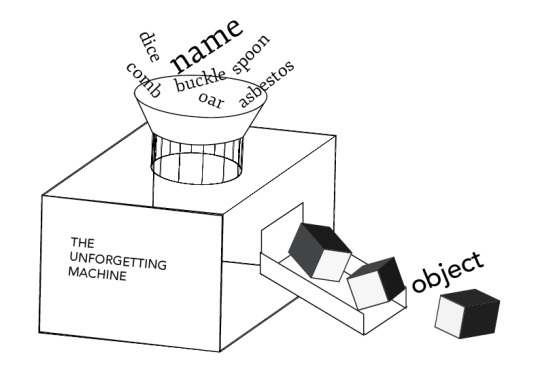
[Debbie Ding. The Library of Pulau Saigon, 2015. PLA Print]
This machine creates a collection of 53 “mutating cultural objects” which are simple and general. Using 3D printing to generate the all-white plastic artefacts displayed in the work, Debbie’s artwork attempts to bridge the gap between the textual description of the object and the actual object itself over time.
ANALYSIS & INTERPRETATION
The overall approach used to create this artwork was very simple and minimalistic, with the artefacts being purposely low in detail and all-white in colour, as well as the font used being the common and generic Times New Roman print, all on a completely grey background. These simple elements used in the curation of this work added to the conveying of the mundane and ordinary nature of the artefacts. The way that the objects were displayed and constructed, including their varying sizes, piqued my curiosity, and I was interested to note that some of the objects did not look like what I would have pictured myself when thinking of the label given to the object. For example, the “Copper Coin” pictured below was much larger than what I pictured it would be like. The whole purpose of this artwork was to understand the gap between the textual description, or label, of the object, and the object itself. The simplistic design elements used in this artwork conveyed the interpretations of the artefacts at their core and rawest forms, beyond the labels that they have been given and been associated with throughout time.
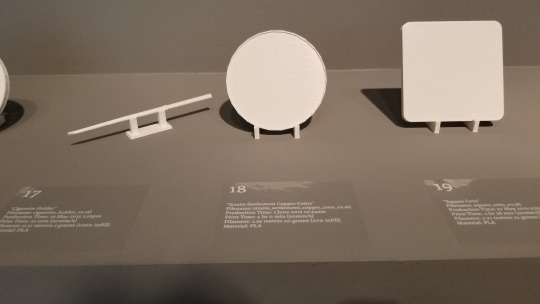
[Debbie Ding. The Library of Pulau Saigon, 2015. PLA Print]
EVALUATION & JUDGMENT
I feel that the Library of Pulau Saigon was a forceful piece in allowing me to analyze my understanding of the gap between an object’s textual description and the object itself. From my gatherings from the artwork, the way the displayed objects were created appear to have been based on several interpretations throughout the timeline of their lives, as they consist of various features from what I assume to be their past, present, and future forms (many of which I likely would not have associated with my current vision of the artefacts). This shows the evident progression in the development of the objects and/or tools that were displayed, which further explains why the prototypes appeared differently from my vision of what they would look like. I felt that this was a very interesting concept for an artwork, and the underlying message that I received from analyzing the work is very relevant in today’s society. The main takeaway I got from this piece was how much evolution and change takes place in the world on a constant basis, and how humans associate with this change. This is especially evident with the uproar of technology in the modern world, and thus this piece continues to pique my interest as there are so many different interpretations that can be demonstrated by it.
Source: http://dbbd.sg/works/the-library-of-pulau-saigon.php
0 notes
Text
WEEK 4: FORUM POST
In your own words, how does the imagination of utopia serve a critical function, compared to rational critique of the Truth, in cultural politics?
A utoipia is an imagined world that is closed to perfect and consists of highly desirable qualities. The imagination of utopia serves a very critical function in cultural politics in relation to digital culture and art, as it is becoming increasingly easy for individuals to portray an image or appearance of perfection to the public, especially with the excessive use of social media in today’s society. Each person that chooses to share posts (i.e. pictures, updates, etc.) has the ability to generate a persona or image of themselves that they desire to display to the world, which may be curated to being better than reality. People have the power more and more to represent themselves in a way that is more desirable or more “perfect”, thus using the imagination of utopia. As such, the rational critique of Truth can often become lost or hard to find and define.
Briefly summarize your understanding of the role of geology in media theory.
From what I gathered from Parrika’s article, geology is important in understanding the materiality of technology and media. It draws a bridge between nature and the human creation of technology. This involves understanding the physicality that technology and media have, using geology to connect media theory to the changes of the environment.
Do you agree with Steyerl’s take on the implications of spam on our political present in “Digital Debris”? Why or why not?
I do agree that the implications on spam on our political present are evident in today’s society. With the large number of media outlets accessible today, including social media platforms, news outlets, etc., we are constantly exposed to all types of news on a daily basis. It has become so easy to spread news of any kind quickly and frequently, and thus we are deeply impacted by spam as it is so accessible to us.
What do you think are the implications that space, context, and curatorial direction can have on an artwork?
An artwork on its own can often be misinterpreted or hard to understand. Space, context, and curatorial direction can help a viewer define and interpret an artwork. They provide the viewer with the setting and conditions that allow the artwork to come into focus for the observer.
0 notes
Text
GROUP MAP: COMMUNICATION DNA
My group and I discussed the Group Map exercise over several meetings, and after brainstorming and putting all our thoughts together, we came up with an idea that incorporated the most significant elements of what digital culture and art means to each of us in our daily lives. We came up with the concept of Communication DNA (pictured below). The changing elements of the methods of communication are pictured on DNA that is merged with an hourglass to display the timeline of the shifts.
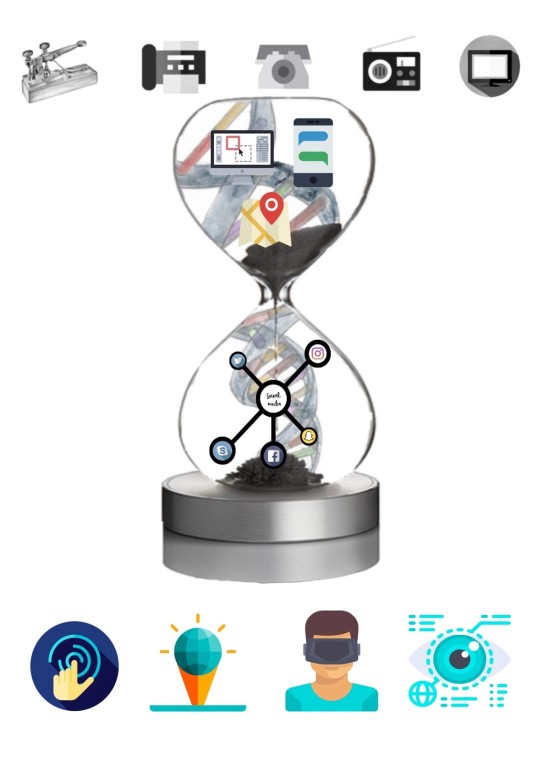
This concept displays the evolution and shift of communication methods throughout time, while maintaining the core concept of communication being part of our fibre as humans, or namely, our DNA. This piece attempts to convey that despite how much time passes, communication will always be a core part of our identity as human beings, and we need it for survival no matter which method is used to get our messages across to one another.
0 notes
Text
WEEK 3: FORUM POST
In your own words, what purpose can a journal serve in the creative process?
A journal is an effective way for an individual to organize and layout his or her thoughts, feelings, and opinions throughout the duration of the creative process. It not only helps brainstorm concepts, it also allows individuals to dive deeper into the though processes and ideas, and acts as inspiration for completing or developing projects.
Why is it valuable to refrain from editing your brainstorming process or discarding “mistakes”?
Editing your brainstorming process or discarding “mistakes” may lead to the derailing of your current train of thought, and this defeats the purpose of using a journal for brainstorming to layout all your uninterrupted thoughts and ideas. The best results always come from laying out all your ideas first, displaying the progress of the thought process, and then editing the ideas and concepts later as a next or final step.
What is the difference between primary and secondary sources? Why do you think it is valuable to include both types of sources when doing research?
Primary sources provide direct or firsthand information, while secondary sources are written or recorded information, often in the forms of historical documents, statistical data, results of experiments, etc. Both are very useful when doing research as primary sources are more reliable, while secondary sources are more abundant and easier to collect. Both should be used when doing research in order to obtain a more holistic collection of evidence or information.
How do you think each level of analysis in the constructive critique model can be useful when incorporated into your journal?
Each level of analysis in the constructive critique model is useful when incorporated into your journal as the levels allow you to provide step by step thoughts and reactions/interpretations to projects and concepts. Using each level allows you to build upon your original thoughts and delve deeper into the concepts so as to discover even more meaning and depth of the concepts as you work through the levels in your journal.
Based on the overview of each exhibition (17 Volcanoes and Radio Malaya), how would you connect each of these exhibitions to your own personal understanding of digital culture?
Both of these exhibitions clearly demonstrated a shift or a change in digital culture of many sorts. The mediums of physical and tangible materials, such as sculptures and paintings, used to display the works in the Radio Malaya exhibition compared to the much more technology-based platforms used in the 17 Volcanoes exhibition clearly define the modern shift in the way that individuals choose to share content and display their art and projects.
0 notes
Text
WEEK 2: DESIGNING FOR HUMAN-FOOD INTERACTIONS
As a foodie, this was a very interesting topic to learn about, as the connection between food and digital culture is very fascinating to become aware of and understand. It was interesting to be introduced to modern ideas and concepts regarding new developments involving food, that are so different from what I have ever seen before. I was particularly interested in the Open Sauce (www.opensauce.cz) concept, as this project allows for both new recipes to become aware of and for individuals from a variety of backgrounds to connect with others over the creation of stories about anything that they wish to share. This idea is a way to use a universal human interest, which is food, to connect people and build relationships with individuals in a creative and expressive way.
My group drew the tarot card pertaining to Ethical Cannibals for the Parlor of Food Futures class exercise. As seen below, the description on the card was “Eat Celebrity Meat”, which in and of itself was a strange and foreign combination of words to read for me and my group members. We experienced some difficulty at first with this task, since we initially could not relate to the topic at all.
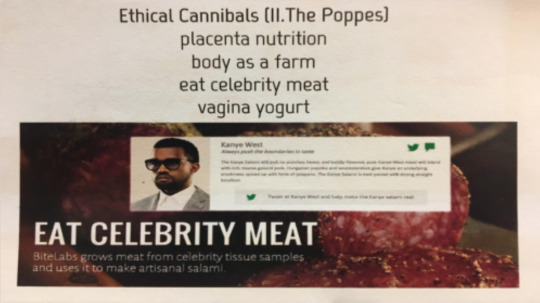
After some brainstorming and deliberation, we were able to connect with the core idea behind the Ethical Cannibals concept, which is to provide a more sustainable alternative to modern meat production. To conserve the world’s resources, tissue samples from celebrities are used to produce edible meat for humans. My group and I was able to connect with the idea of creating a more sustainable earth, and as such we were able to come up with the concept of a Body Farm (rough draft pictured below), in which we use parts of the human body that can be regenerated to create foods. The shower in the Body Farm extracts and filters the human excretions that can be regenerated, such as hair, saliva, sweat, nails, etc., and turns these into food.
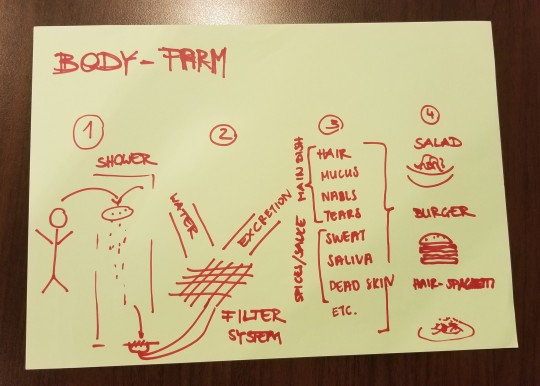
Below is the final product of our Body Farm:

0 notes
Text
WEEK 2: FORUM POST
What are the three main approaches to critical design practice?
The three main approaches to critical design practice are: 1) designers reflecting on and critically questioning their own design practice; 2) an approach based on a macro-perspective, re-thinking the design discipline as such; 3) an approach directed towards broader social and political phenomena.
In your own words, how does speculative design differ from conventional/commercial design?
Speculative design is an approach focused more on imagining, or “speculating”, possible future alternatives, usually revolving around the impact of new technologies, and may not always be an accurate reflection of reality. Conventional/commercial design focuses more on current market trends and demands in order to satisfy customer needs.
Discuss the current criticism of the current dominant approach to speculative practice: "Eurocentric ... excessive focus on aesthetics, tendency to escape to dystopian scenarios, vanity and separation from the real world." Based on the Food Design Speculations examples on the Lesson plan, the Project examples in the Dunne and Raby website, or any other examples you can find (please cite a couple to support your arguments, you don't have to use all of them), do you agree with these criticisms?
I do agree to a certain extent with the current criticisms arguing that speculative practice is Eurocentric, excessively focused on aesthetics, and separates from the real world. Using the “Bite Labs” project as an example (http://www.bitelabs.org/), while it can be argued that this initiative takes on a Eurocentric positioning by relying on the use of celebrities from the Western World to both promote and participate in the project, the core idea of this project is not a complete separation from the real world. The main purpose of Bite Labs is to provide “The Future of Meat” in order to create a more sustainable world. The notion of creating a new process or design to replace the current unsustainable process [of meat production] touches upon a very prevalent issue in the real world today of sustainability and prevention of resource depletion. However, the execution of this initiative can quite clearly be argued as Eurocentric and overly-focused on aesthetics.
0 notes